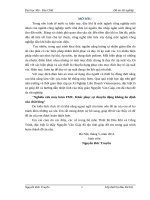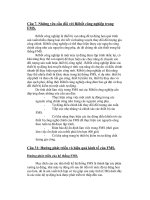10376 fm
Bạn đang xem bản rút gọn của tài liệu. Xem và tải ngay bản đầy đủ của tài liệu tại đây (279.15 KB, 8 trang )
Handbook of
Industrial
Chemistry
Organic Chemicals
Mohammad Farhat AIi, Ph.D.
King Fahd University of Petroleum & Minerals
Dhahran, Saudi Arabia
Bassam M. El AIi, Ph.D.
King Fahd University of Petroleum & Minerals
Dhahran, Saudi Arabia
James G. Speight, Ph.D.
CD&Wlnc.
Laramie, Wyoming
McGraw-Hill
New York
Chicago San Francisco Lisbon London Madrid
Mexico City Milan New Delhi San Juan Seoul
Singapore Sydney Toronto
CIP Data is on file with the Library of Congress
Copyright © 2005 by The McGraw-Hill Companies, Inc. AU rights
reserved. Printed in the United States of America. Except as permitted
under the United States Copyright Act of 1976, no part of this publication
may be reproduced or distributed in any form or by any means, or stored
in a data base or retrieval system, without the prior written permission
of the publisher.
1234567890
DOC/DOC
010987654
ISBN 0-07-141037-6
The sponsoring editor for this book was Kenneth P. McCombs and the
production supervisor was Pamela A. Pelton. It was set in Century
Schoolbook by International typesetting and Composition. The art
director for the cover was Anthony Landi.
Printed and bound by RR Donnelley.
This book is printed on recycled, acid-free paper containing a
minimum of 50% recycled, de-inked fiber.
McGraw-Hill books are available at special quantity discounts to use as
premiums and sales promotions, or for use in corporate training programs. For more information, please write to the Director of Special
Sales, McGraw-Hill Professional, Two Penn Plaza, New York, NY 101212298. Or contact your local bookstore.
Information contained in this work has been obtained by The
McGraw-Hill Companies, Inc. ("McGraw-Hill") from sources
believed to be reliable. However, neither McGraw-Hill nor its
authors guarantee the accuracy or completeness of any information
published herein, and neither McGraw-Hill nor its authors shall be
responsible for any errors, omissions, or damages arising out of use
of this information. This work is published with the understanding
that McGraw-Hill and its authors are supplying information but are
not attempting to render engineering or other professional services.
If such services are required, the assistance of an appropriate professional should be sought.
To our wives and families, and to all scientists
and engineers who preceded us in such work
ABOUTTHE EDITORS
is Professor of Industrial and
Petroleum Chemistry at King Fahd University of Petroleum
& Minerals in Saudi Arabia. An expert in characterization
studies of heavy ends, residues, and asphalt, he is also knowledgeable about crude oils and products, refining process
technology, waste oil recycling, and stability characteristics
of jet fuels.
MOHAMMAD FARHAT ALI, PH.D.,
BASSAM M. EL ALI, PH.D.,
is Professor of Industrial
Chemistry at King Fahd University of Petroleum &
Minerals in Saudi Arabia. His specialties include
homogenous and heterogeneous catalysis using transition
metal complexes in hydrocarboxylation, hydroformylation,
oxidation, coupling, hydrogenation, and other important
processes; investigation of the organometallic intermediates
and the mechanisms of various homogenous reactions; and
synthesis, characterization, and application of various
supported catalytic systems in the production of fine
chemicals. He has taught many industrial chemistry
courses including Industrial Catalysis, Industrial Organic
Chemistry, Industrial Inorganic Chemistry, and Petroleum
Processes.
G. SPEIGHT, PH.D., has more than 35 years' experience
in fields related to the properties and processing of conventional and synthetic fuels. He has participated in, and led,
significant research in defining the uses of chemistry with
heavy oil and coal. The author of well over 400 professional
papers, reports, and presentations detailing his research
activities, he has taught more than 50 related courses.
Dr. Speight is the author, editor, or compiler of a total of
25 books and bibliographies related to fossil fuel processing
and environmental issues. He lives in Laramie, Wyoming.
JAMES
Contributors
Hasan A. Al-Muallem, Ph.D.
Department of Chemistry
King Fahd University of
Petroleum & Minerals
Dhahran, Saudi Arabia
Mohammad Farhat AIi, Ph.D.
Professor of Chemistry
Department of Chemistry
King Fahd University of
Petroleum & Minerals
Dhahran, Saudi Arabia
Bassam M. ElAIi, Ph.D.
Professor of Chemistry
Department of Chemistry
King Fahd University of
Petroleum & Minerals
Dhahran, Saudi Arabia
Manfred J. Mirbach, Ph.D.
Landis Kane Consulting
R&D Management
Fuellinsdorf, Switzerland
Ahsan Shemsi
Department of Chemistry
King Fahd University of
Petroleum & Minerals
Dhahran, Saudi Arabia
James G. Speight, Ph.D.
CD&W Inc.
Laramie, Wyoming
Preface
The organic chemical industry is an important branch of industry and
its structure usually centers on petroleum and hydrocarbon derived
chemicals. The volume text of available books is generally lacking in covering other very important nonpetroleum-based organic industries such
as paints, dyes, edible oils, fats and waxes, soaps and detergents, sugars,
fermentation, chemical explosives, and agrochemical industries.
This book focuses primarily on the chemical processing of raw materials other than petroleum and hydrocarbons. These materials are usually converted into useful and profitable products that are, in general,
used as consumer goods. The book addresses the needs of both students
and practicing chemists and chemical engineers. It is intended to be a
primary source of information for the young practicing professionals
who wish to broaden their knowledge of the organic process industry as
a whole. The book may also serve as a textbook for advanced undergraduate students in industrial chemistry.
Chapter 1 describes the development of the chemical industry and its
role in welfare and employment around the world. This chapter shows
how raw materials are procured and converted to consumer products.
Chapter 2 discusses safety aspects in organic industries and methods
to protect the workers from hazards such as exposure to dangerous
chemicals, heat, pressures, high electric fields, accelerating objects, and
other sources of hazards.
Chapter 3 deals with the sources of pollution caused by raw materials, products, and wastes in petroleum, petrochemicals, pharmaceuticals, food, and other industries. The growing public concerns over the
safety of chemicals in the environment, and the efforts by the governments and industries for their control, are discussed.
Chapter 4 presents the chemistry and technology of edible oil, fat, and wax
processing including refining, recovery, crystallization, interesterification,
and hydrogenation. The key oxidation reactions of lipids leading to quality
deterioration of processed and unprocessed foods, and the mechanism of
the action of the antioxidants in improving oxidation stability of foods are
discussed.
Chapter 5 highlights the soap and detergent industry. The raw materials, important processes of production, and economic importance of the
soap and detergent industry are elaborated.
Chapter 6 covers one of the most widely distributed and abundant
organic chemicals—the sugars. The chemistry of saccharides, historical
survey, and world production of sugar are presented. The sugar recovery from the two principal sources—sugar cane and sugar beets—are
discussed. The chemistry and uses of nonsugar sweetening agents is
also presented.
Chapter 7 describes paints, pigments, and industrial coatings. The
major paint components, namely, pigments, binders, additives, and solvents are discussed in separate sections. These are followed by the principles of formulation, application techniques, durability, and testing of
paints.
Chapter 8 is devoted to the industrially produced dyes with their classification, manufacture, properties, and main applications, as well as
environmental and health aspects.
Chapter 9 presents an overview of modern fermentation processes and
their application in food, pharmaceutical, and industrial chemical industries. The social and economic importance of fermentation processes is
discussed.
The pharmaceutical industry is presented in Chapter 10 as one of the
most important sectors of healthcare worldwide. The discovery, the
development, and the production of drugs are covered in this chapter.
The chapter also includes the correlation between the growth in the
worldwide market for Pharmaceuticals and the increase of the world
population as a result of higher life expectancy and changes in lifestyle.
Chapter 11 presents an overview of the agrochemical industry.
Beginning with the introduction and historical background, it leads to
the modern trends in agriculture, chemical pest control, herbicides,
fungicides, insecticides, and biological pest control agents. Social and
economic aspects of pesticides use are also discussed.
Chapter 12 presents the chemistry of explosives. Chemical explosives
and propellants are well-covered in this book because of their importance
for peaceful uses. They are considered chemical compounds in pure form
or mixtures that rapidly produce a large volume of hot gases when
properly ignited. The destructive effects of explosives are much more
spectacular than their peaceful uses. However, it appears that more
explosives have been used by industries for peaceful purposes than in
all the wars.
Chapter 13 covers the conversion of crude oil into desired products in
an economically feasible and environmentally acceptable manner.
Descriptions are provided for (1) desalting and dewatering; (2) separation processes, of which distillation is the prime example; (3) conversion
processes, of which coking and catalytic cracking are prime examples;
and (4) finishing processes, of which hydrotreating to remove sulfur is
a prime example. Descriptions of the various petroleum products (from
fuel gas to asphalt and coke) are also given.
This chapter also includes a description of the petrochemical industry, and the production of the chemicals and compounds in a refinery that
are destined for further processing, and used as raw material feedstocks
for the fast-growing petrochemical industry.
Chapter 14 provides the basic principles of polymer science, and
addresses the importance of this subject. This chapter aims to give a
broad and unified description of the subject matter—describing the
polymerization reactions, structures, properties, and applications of
commercially important polymers, including those used as plastics,
fibers, and elastomers. This chapter focuses on synthetic polymers
because of the great commercial importance of these materials. The
chemical reactions by which polymer molecules are synthesized are
addressed along with the process conditions that can be used to carry
them out. This chapter also discusses topics on degradation, stability,
and environmental issues associated with the use of polymers.
This book is intended for university and college students who have
studied organic chemistry, as well as for scientists and technicians who
work in the organic chemical industry, and senior executives and specialists who wish to broaden their knowledge of the industrial organic
processes as a whole.
At the end, we gratefully acknowledge the financial aid, facilities,
and support provided by the Deanship of Scientific Research at King
Fahd University of Petroleum & Minerals, Dhahran, Saudi Arabia.
Mohammad Farhat AU, Ph.D.
Bassam M. ElAIi, Ph.D.
James G. Speight, Ph.D.









